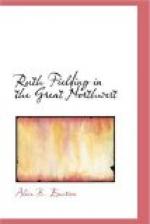Benbow Camp lay well up behind Hubbell Ranch, yet in a well sheltered valley where scarcely a threat of winter had yet appeared. A big crew of lumbermen was at work on the site, and many of these men Mr. Hammond used as extras in the scenes indicated in Ruth’s script.
Ruth had now gained so much experience in the shooting of outdoor scenes that her descriptions in this story of “Brighteyes,” the Indian maid, were easily visualized by the director. Besides, she stood practically at Jim Hooley’s elbow when the story was being filmed. So, with the author working with the director, the picture was almost sure to be a success. At least, the hopes of all—including those of Mr. Hammond, who had already put much money into the venture—began to rise like the quicksilver in a thermometer on a hot day.
The small river on which locations had been arranged for was both a boisterous and a picturesque stream. There were swift rapids ("white water” the woodsmen called it) with outthrust boulders and many snags and shallows where a canoe had to be very carefully handled. Several scenes as Ruth had written them were of the Indian girl in a canoe. Wonota handled a paddle with the best of the rivermen at Benbow Camp. There was no failure to be feared as to the picture’s requirements regarding the Indian star, at least.
Having seen the scenes of the prologue shot and got the company on location at Benbow Camp, Mr. Hammond went back to the railroad to get into communication with the East. He had other business to attend to besides the activities of this one company.
Scenes along the bank and at an Indian camp set up in a very beautiful spot were shot while preparations for one of the big scenes on the stream itself were being made.
The text called for a freshet on the river, in which the Indian maid is caught in her canoe. The disturbed water and the trash being borne down by the current was an effect arranged by Jim Hooley’s workmen. The timbermen working for the Benbow Company helped.
A boom of logs was chained across the river at a narrow gorge. This held back for two nights and a day the heavy cultch floating down stream, and piled up a good deal of water, too, for the boom soon became a regular dam. Below the dam thus made the level of the stream dropped perceptibly.
“I am going to put Wonota in her canoe into the stream above the boom,” Hooley explained. “When the boom is cut the whole mass will shoot down ahead of the girl. But the effect, as it comes past the spot where the cameras are being cranked, will be as though Wonota was in the very midst of the freshet. She handles her paddle so well that I do not think she will be in any danger.”
“But you will safeguard her, won’t you, Mr. Hooley?” asked Ruth, who was always more or less nervous when these “stunt pictures” were being taken.
“There will be two canoes—and two good paddlers in each—on either side of Wonota’s craft, but out of the camera focus of course. Then, we will line up a lot of the boys along the shore on either side. If she gets a ducking she won’t mind. She understands. That Indian girl has some pluck, all right,” concluded the director with much satisfaction.




